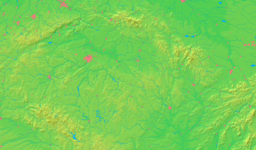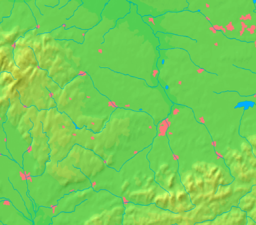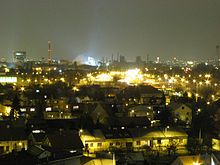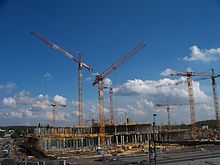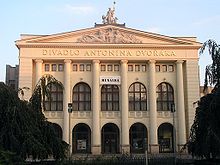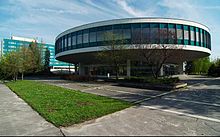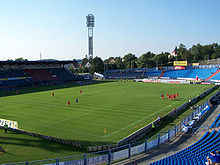- Ostrava
-
Ostrava City FlagCoat-of-armsCountry Czech Republic Region Moravian-Silesian Little District Ostrava Parts 23Center Masarykovo náměstí - elevation 260 m (853 ft) - coordinates 49°50′08″N 18°17′33″E / 49.83556°N 18.2925°E Area 214 km2 (83 sq mi) - metro 3,896 km2 (1,504 sq mi) Population 310 464 (January 2011) - metro 1 164 328 [1] Density 1,450 / km2 (3,755.5 / sq mi) Founded 1267 Mayor Ing. Petr Kajnar (ČSSD, 2006–2010, 2010–2014) Postal code 702 00 Website: www.ostrava.cz Ostrava (Czech pronunciation: [ˈostrava] (
 listen), German: Ostrau, Polish: Ostrawa) is the third largest city in the Czech Republic and the second largest urban agglomeration after Prague. Located close to the Polish border, it is also the administrative center of the Moravian-Silesian Region and of the Municipality with Extended Competence[clarification needed]. Ostrava was candidate for the title of European Capital of Culture 2015.[2] Ostrava is located at the confluence of the Ostravice, Oder, Lučina and Opava rivers. Its history and growth have been largely affected by exploitation and further use of the high quality black coal deposits discovered in the locality, giving the town a look of an industrial city and a nickname of the “steel heart of the republic” (Czech: ocelové srdce republiky) during the communist era of Czechoslovakia. Many of the heavy industry companies are being closed down or transformed, yet the city remains one of the most polluted in the EU.
listen), German: Ostrau, Polish: Ostrawa) is the third largest city in the Czech Republic and the second largest urban agglomeration after Prague. Located close to the Polish border, it is also the administrative center of the Moravian-Silesian Region and of the Municipality with Extended Competence[clarification needed]. Ostrava was candidate for the title of European Capital of Culture 2015.[2] Ostrava is located at the confluence of the Ostravice, Oder, Lučina and Opava rivers. Its history and growth have been largely affected by exploitation and further use of the high quality black coal deposits discovered in the locality, giving the town a look of an industrial city and a nickname of the “steel heart of the republic” (Czech: ocelové srdce republiky) during the communist era of Czechoslovakia. Many of the heavy industry companies are being closed down or transformed, yet the city remains one of the most polluted in the EU.Contents
Etymology
Ostrava was named after the river Ostrá (meaning sharp) which today is called Ostravice.
History
Ostrava was an important crossroads of prehistoric trading routes, namely the Amber Road. Archaeological finds have proved that the area around Ostrava has been permanently inhabited for 25,000 years. Circa 23,000 BC, the Venus of Petřkovice (Petřkovická venuše in Czech) from Petřkovice in Ostrava, Czech Republic, was made. It is now in Archeological Institute, Brno. In the 13th century, the Ostravice river marked the border between the Silesian duchy of Opole and the March of Moravia under Bohemian suzerainty. Two settlements arose on both sides of the river: Slezská Ostrava (Silesian Ostrava) was first mentioned in 1229, Moravská Ostrava (Moravian Ostrava) in 1267, it received town privileges in 1279. The Piast dukes of Opole in 1297 built a fortress on their side of the river. Both parts were largely settled by Germans in the course of the Ostsiedlung.
Until the late 18th century, Moravská Ostrava was a small provincial town with a population around one thousand inhabitants engaged in handicraft. In 1763, large deposits of black coal were discovered, leading to an industrial boom and a flood of new immigrants in the following centuries. During the 19th century, several mine towers were raised in and around the city and the first steel works were established at Vítkovice, acquired by Salomon Mayer von Rothschild in 1843. Industrial growth was made possible by the completion of Kaiser-Ferdinands-Nordbahn from Vienna in 1847. The 20th century saw further industrial expansion of the city accompanied by an increase in population and the quality of civic services and culture. However, during World War II, Ostrava – as an important source of steel for the arms industry – suffered several massive bombing campaigns that caused extensive damage to the city.
Since the Velvet revolution in 1989 the city has been going through major changes. A thorough restructuring of industry is taking place – coal mining in the area of the city was stopped in 1994 and a large part of the Vítkovice ironworks near the city center was closed down in 1998. Both actions improved the environment dramatically, although the Arcelor Mittal plant (ex-Nová Huť) continues to heavily pollute the Radvanice district and the surrounding area, resulting in one of the highest concentrations of PM10 dust in Europe.[3]
Historical population
1970 1975 1980 1985 1990 1995 2000 2005 2010 279,209 300,799 326,929 327,608 331,466 324,813 320,041 310,078 311,419 Mayors
Period Name 1861–1864 Hermann Zwierzina 1864–1873 Alois Anderka 1873–1880 Konstantin Grünwald 1880–1888 Anton Lux 1888–1901 Adalbert Johanny 1901–1918 Gustav Fiedler 1918 Johann Ulrich (until 17 December 1918) 1918–1935 Jan Prokeš 1935–1939 Josef Chalupník 1939–1940 Josef Hinner 1940–1945 SS Sturmbannführer Emil Beier 1945 Josef Lampa (interim, for three weeks) 1945–1960 Josef Kotas 1960–1964 Jan Buchvaldek 1964–1968 Josef Kempný 1968–1971 Zdeněk Kupka 1971–1986 Eduard Foltýn 1986–1989 Bedřich Lipina 1989–1990 Lubomír Vejr 1990–1993 Jiří Smejkal 1993–2001 Evžen Tošenovský 2001–2002 Čestmír Vlček 2002–2006 Aleš Zedník 2006–2014 Petr Kajnar Geography and climate
Climate data for Ostrava Month Jan Feb Mar Apr May Jun Jul Aug Sep Oct Nov Dec Year Average high °C (°F) 0.4
(32.7)2.8
(37.0)7.7
(45.9)13.5
(56.3)18.9
(66.0)21.9
(71.4)23.6
(74.5)23.4
(74.1)19.4
(66.9)14.0
(57.2)6.7
(44.1)2.0
(35.6)12.86
(55.14)Average low °C (°F) −5.6
(21.9)−4.1
(24.6)−0.8
(30.6)3.0
(37.4)7.3
(45.1)10.6
(51.1)11.9
(53.4)11.6
(52.9)8.7
(47.7)4.7
(40.5)0.9
(33.6)−3.2
(26.2)3.75
(38.75)Precipitation mm (inches) 26.7
(1.051)30.2
(1.189)34.0
(1.339)52.4
(2.063)91.2
(3.591)104.4
(4.11)91.1
(3.587)91.8
(3.614)58.8
(2.315)42.3
(1.665)44.6
(1.756)34.3
(1.35)701.8
(27.63)Avg. precipitation days 7 7 7 8 11 11 11 10 8 7 9 8 104 Source: World Meteorological Organisation (UN)[4] Ostrava is located in the north-eastern area of the Czech Republic, very close to the Polish (15 km (9.3 mi)) and Slovak (55 km (34 mi)) borders. It spreads over the northern part of the natural north-south valley called the Moravian Gate (Moravská brána) with an average elevation of approximately 210 m (690 ft) above sea level.
The local climate is continental temperate, with hot, humid summers and mild, dry winters. The yearly average temperature is 10.2 °C (50.4 °F) (January low: −1.2 °C (29.8 °F), July high: 25 °C (77 °F)), the yearly rainfall is around 526 mm (20.7 in).
People and demographics
As of January 2011, the official estimated population of Ostrava was 310,464 inhabitants, living in a total of 23 districts formed by the unification of 34 original small towns and villages. Ostrava covers an area of 214 km². The population density is 1450 people per km².
Historically, among the most influential ethnic groups besides Czechs in Ostrava were the Poles, Germans and the Jews. However, during and after the World War II years the situation changed completely, as most Ostravian Jews were killed or transported to concentration camps (on 17 October 1939, the first transport of Jews to a camp under the Nisko Plan, and the Nazi administrative innovation known as the General Government was held in Ostrava – the first of its kind in Europe). After World War II, Germans were expelled from Ostrava according to the Potsdam Agreement. Thus, the population of the city, has become a mixture of Silesians, Moravians, Czechs, Slovaks and Poles. The mayor of Ostrava Josef Hinner opposed the deportation with the magistrate and German forces and started to organize the resistance to smuggle Jewish citizens from the city and surrounding areas. Due to his opposition, mayor Hinner was deported and placed in a concentration camp, barely surviving World War II.
The unemployment rate is 12 % (as of December 2010).
Steel industry and underground coal mines
All underground coal mines were closed down shortly after the Velvet revolution in 1989, due to unfavourable geological and political conditions which caused mining to become uneconomical in the post-communist system, and also because of ex-mayor Evžen Tošenovský's drive to modernize the city's industries. The last minecart with coal was retrieved from new Odra Mine (formerly František Mine) on 30 June 1994.[5]
Some of the largest industrial companies lie in the city of Ostrava. The Vitkovice steel works, located in the suburb of the same name near the city center, concentrates on metallurgy and machine engineering. It was established in 1828 and now it is undergoing a major transformation. The Vítkovice complex Dolní oblast is set to undergo extensive reconstruction. The giant gas container for blast furnace gas (around 70 m wide and 33 m high) will be modified into a concert hall for 1,500 visitors, a gallery, café, etc., based on design by leading Czech architect, Josef Pleskot. Blast Furnace no 1 will become the start of a tour route, and the sixth energy central office will become an industrial museum (project authored by Václav and Helena Zemánkový). The expected date for completion of reconstruction is set for 2013.
Michal Mine whose history goes back to 1843, is an extremely valuable authentic industrial site in terms of construction and technical equipment. the museum provides visitors with the chance to look over all of the above ground work areas that a miner would have to go through to get to his shift. The tour includes, the dressing rooms, washrooms, registry, dispatching, and most importantly, the machine room, with its original and unique equipment that had worked until 1993, when the mine was permanently closed. The scene, intentionally left intact, without any artificial arrangements being made, gives the impression as if work there has just ended. Some of the rooms in the Museum house also other kinds of temporary exhibitions, often displaying works by foreign artists.
Located on the former Anselm Mine (one of the first to be established at the end of the 18th century in what is today the Petřkovice District of Ostrava), the Mining Museum was opened in the early 1990s. A unique exhibition of the Mining Museum highlights the evolution of coal mining in the Ostrava-Karvina region, as well as mining technology, and rescue services. In fact, it is the largest exhibition of its kind in the world. With the collection of miner’s lights and hand tools, visitors get a real taste of the hard work and dedication the men of the mines had. The tour includes a view of mining in the original seams with wooden braces, mining machines and belt conveyors.
Karolina
Karolina is the name of an area approximately 30 hectares in size situated 500 m (1,600 ft) from the city's historic square. The Karolína area was originally used for heavy industry. After demolition of the old coking plant and clearing the entire area, the Karolina site can now be used to extend the Ostrava city center.
In late June 2006, the Dutch firm Multi Development won the contract to develop the grounds of the former Karolina site. Multi Development plans to invest 13 billion CZK (EUR 450 million).
Many new apartment buildings, offices and shops are planned for this new city district. There will also be a new church, a high-rise building, a large park by the Ostravice River and a university campus.
Culture
There are four theaters in Ostrava: Moravian-Silesian National Theatre (Národní divadlo moravskoslezské). It has two buildings: Divadlo Antonína Dvořáka (named after Antonín Dvořák) and Divadlo Jiřího Myrona. Further there are Petr Bezruč Theatre (named after Petr Bezruč), Komorní scéna Aréna (Chamber theatre Arena) and Divadlo loutek (Puppet theatre).
Every July there is an international world music festival Colours of Ostrava taking place.
Ostrava's Janáček Philharmonic Orchestra (formerly called the Czech Radio Orchestra) is one of Europe's better orchestras.
Ostrava was candidate for the European Capital of Culture 2015.
Education
- VŠB – Technical University of Ostrava
- University of Ostrava
- Business School Ostrava plc
Main sights
While Ostrava is usually not in the top ten list of tourist attractions of the Czech Republic, there are a number of interesting places to see and things to do there.
Some technical landmarks, such as Lower Vítkovice Area, the Michal Mine, and/or Landek Park, with its Mining Museum exhibition, have no match within the entire Czech Republic.
Another attraction, which is becoming more and more popular mainly among young people, is Stodolní Street (Stodolní ulice), actually a collection of streets just next to the center, full of bars, pubs and clubs, bringing night-life to the city and thousands of visitors all year long. There are currently around 60 places to have a drink or dance on this street, each with its own style and atmosphere. There are a few bigger events at this area throughout the year, the largest of which is the Colours of Ostrava a summer music festival hosting many musicians and groups from all over the world.
The New City Hall Viewing Tower provides visitors a panoramic view of the city and surroundings from a height of about 72 m (236 ft). In clear weather, the Moravian-Silesian Beskids and Jeseníky mountain ranges are visible.
The Silesian Ostrava Castle is one of the city's most historic cultural monuments. The castle was built in the eighties and nineties of the 13th century. In 1534, the gothic castle was rebuilt into a renaissance chateau. It was restored recently after many years of dilapidation caused by coal mining under the castle. Today, the castle is one of the most important tourist attraction of the city. It hosted the Colours of Ostrava music festival in 2007.
The Ostrava ZOO was founded in 1949 and officially opened in 1951; the zoo originally had only eight animals: three roes and five pheasants. Since that time, it has expanded to include 230 species of animals and, after relocation in 1956 to its current place, has grown from its original 0, 5 km2 to 3 km2 today. The most favourite children attraction is called Petting Zoo, where children could go right to the exhibition with goats and sheep. Every day, people can go to watch special commented feedings of animals, where a worker feeds an animal and talk about the animal and answer people’s question. The 230 species are housed in outdoor and indoor exhibits which include: African mammal house, monkey house, elephant house, 3 aviaries for birds, small Amazonia, hippo house. The Ostrava zoo was the first in the Czech Republic to see the birth of an elephant. Two elephants were born in 2011. The elder, a male named Sethi, died after a two months. The second one, a female named Rashmi, has flourished and can be visited in the elephant pavilion.
The Miniuni is a collection of over thirty 1:25 models of Europe's prominent edifices spreading across a 1.5ha area. Some of the exhibits are Prague's Old Town Hall, London's Big Ben, Berlin's Brandenburg Gate and a dominant 12m tall Eiffel Tower. The exhibition also features the Seven World Wonders and the World's Skyscrapers. Railways with model trains and water canals with model steamers add extra fun.
The Ostrava museum was established by merging three older local museums in the Old Post-Office building after World War One. Since 1931 it occupies the Old Town Hall in Masaryk Square, the oldest existing example of original historic architecture typical of Ostrava's city core. On display are local history of Ostrava and a couple of other theme shows. Its singular feature and pride item is the 225 cm (88.58 in) tall indoor astronomical clock called the Mašek Clock. It boasts 51 different functional features and consists of four dials: clock, calender, astronomical and planetary dials.
The Fire-fighting Museum' building has been dedicated to fire-fighting since its completion in 1905. The exhibition features seven sections showing models of fire trucks and other fire-fighting hardware; model situations like fire, leaks of dangerous substances and traffic accidents; an exhibition of history and development of fire-fighting techniques and technology; breathing apparatuses and personal protection gear for chemical accident operations. Video features and documentaries show and explain the Whats and Whys of a fireman's job.
In the Ostravar brewery, an excursion route has been traced for visitors, who will be able to learn interesting things about the brewing of the Czech national drink. At the end of the route, visitors can taste their favourite brew. A great attraction of the Museum is a tap bar that is more than 60 years old. In addition to the tap-room, visitors can see a number of other interesting objects linked with brewing. There are, for example, specimens of barrels with illustrations of how they were made, transport glasses dating from the 1920s and 1930s and a historical barrelhead. All this is accompanied by historical photographs and labels.
The Ema Heap, made up of dirt, or mining waste material, from The Trinity Colliery, is now a favourite Sunday trip destination. It is 82 ha large and contains some 4 mil. cube meters of dirt. Spontaneous ignition appeared deep in its bowels in the 1960s and the invisible fire still keeps burning. Inside temperature reaches up to 1,500 °C (2,732 °F) creating suitable habitats for steppe species of fauna and flora along the dump limits. Extreme temperature produces rare minerals inside this man-made singularity of nature. Visitors should follow the marked yellow path.
Sport
Ostrava has teams in the four major Czech Republic professional sports leagues (football, ice-hockey, basketball and floorball). The city's two current League football teams are FC Baník Ostrava and FC Vítkovice. FC Baník Ostrava represent the city in the Czech Republic 1. League (Gambrinus Liga).
In ice-hockey, Ostrava has one team HC Vítkovice Steel represent the city in the Czech Extraliga and HC Poruba in second league.
The city's National Basketball League (NBL) team is the NH Ostrava.
In Ostrava are two teams in the first floorball league. 1. SC WOOW Vítkovice and FBC Ostrava.
Ostrava also supports athletics. Ostrava-Vítkovice hosts the Golden Spike athletics meeting, one of the IAAF World Challenge Meetings.
Transport
Public Transport
Public transport infrastructure consists of 17 tram (streetcar), 9 trolleybus, 59 day bus lines. Service is provided mainly by Dopravní Podnik Ostrava a.s. (Ostrava City Transportation Company).
Rail
Ostrava lies on the main rail route connecting Vienna and Warsaw. Ostrava, as a third largest city, has direct train connection with the capital city Prague. Some EuroCity trains go also to Žilina and Košice.
Air
Leoš Janáček Airport Ostrava serves a number of domestic and international destinations.
International relations
Twin towns – Sister cities
See also: List of twin towns and sister cities in the Czech Republic Volgograd, Russia, from 1957
Volgograd, Russia, from 1957 Coventry, United Kingdom, from 1957
Coventry, United Kingdom, from 1957 Katowice, Poland, from 1960
Katowice, Poland, from 1960 Dresden, Germany, from 1971[6]
Dresden, Germany, from 1971[6] Split, Croatia, from 1976
Split, Croatia, from 1976 Piraeus, Greece, from 1997
Piraeus, Greece, from 1997 Košice, Slovakia, from 2001[7]
Košice, Slovakia, from 2001[7] Miskolc, Hungary, from 2001
Miskolc, Hungary, from 2001 Pittsburgh, USA, from 2001
Pittsburgh, USA, from 2001 Powiat Wodzisławski, Poland, from 2005
Powiat Wodzisławski, Poland, from 2005 Western, Kazakhstan, from 2008
Western, Kazakhstan, from 2008 Donetsk, Ukraine, from 2009
Donetsk, Ukraine, from 2009
Ostrava has two triangular partnerships with Coventry: one with Volgograd since 1957 and one with Dresden since 1971.
The Consulate-General of the Republic of Poland is located on Blahoslavova Street in Ostrava.
An honorary consulate of the Russian Federation is also located in Ostrava.[8][9]
People
- Kateřina Baďurová
- Jan Balabán
- Tomáš Čermák
- Andreas Dombrowski
- Ota Filip
- Nikola Jirásková
- Artur London
- Věra Chytilová
- Marek Jankulovski
- Petr Kalus
- Viktor Kolář
- Filip Kuba
- Ivan Lendl
- Mario Licka
- Petr Šnapka
- Evžen Tošenovský
- Dieter Uchtdorf
- Jan Veselý
- Max Walter
- Tarra White
Notes
- ^ Larger urban zone, Eurostat 2003
- ^ www.ostrava2015.cz Ostrava 2015 – it lost by 6 to 5 to Pilsen
- ^ "Ostravsko už ví, proč má špatný vzduch. Špiní jej hutě". 2008. http://aktualne.centrum.cz/domaci/zivot-v-cesku/clanek.phtml?id=519268. Retrieved 4 July 2008.
- ^ "World Weather Information Service – Ostrava". United Nations. http://www.worldweather.org/172/c00920.htm. Retrieved 21 January 2011.
- ^ "Historie hornictví – Důl František, Ostrava – Přívoz (Czech language)". Hornictvi.info. 11 August 2009. http://www.hornictvi.info/histhor/lokality/okr/08.htm. Retrieved 30 September 2009.
- ^ "Dresden – Partner Cities". 2008 Landeshauptstadt Dresden. http://www.dresden.de/en/02/11/c_03.php. Retrieved 29 December 2008.[dead link]
- ^ "Partnership towns of the City of Košice" (in Slovak). 2007–2009 City of Košice Magistrát mesta Košice, Tr. SNP 48/A, 040 11 Košice. http://www.kosice.sk/clanok.asp?file=gov_s_c-00.html. Retrieved 12 July 2009.
- ^ Honorární konzulát Ruské federace v Ostravě
- ^ Honorary consulate of the Russian Federation in Ostrava.
External links
- Ostrava travel guide from Wikitravel
- (Czech) Official web
- (English) DPO – Public Transport in Ostrava
- (English) City information center
- (English) Zoo Ostrava official website
- (English) Ostrava is candidate for the title of European Capital of Culture 2015
- (English) MÄHRISCH-OSTRAU 1923
Towns and villages of Ostrava-City District Čavisov · Dolní Lhota · Horní Lhota · Klimkovice · Olbramice · Ostrava · Stará Ves nad Ondřejnicí · Šenov · Václavovice · Velká Polom · Vratimov · Vřesina · ZbyslaviceAdministrative seats of Czech regions  Brno • České Budějovice • Hradec Králové • Jihlava • Karlovy Vary • Liberec • Ostrava • Olomouc • Pardubice • Plzeň • Prague • Ústí nad Labem • Zlín
Brno • České Budějovice • Hradec Králové • Jihlava • Karlovy Vary • Liberec • Ostrava • Olomouc • Pardubice • Plzeň • Prague • Ústí nad Labem • Zlín Categories:
Categories:
Wikimedia Foundation. 2010.



